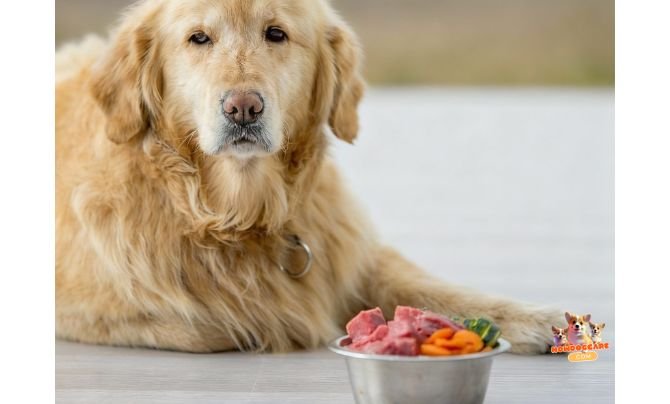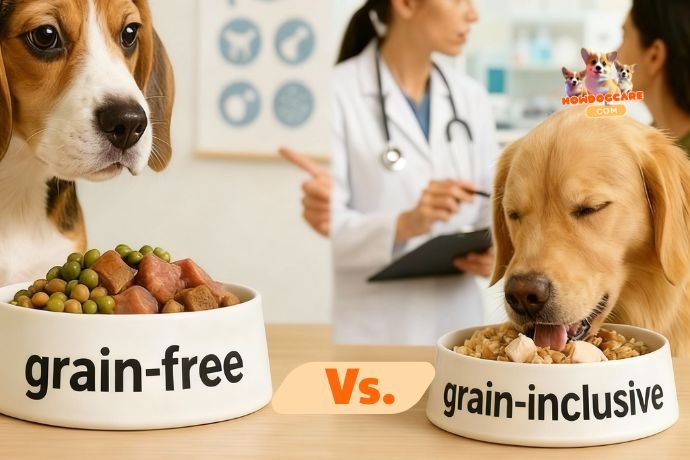In 2026, pet parents are more informed than ever, but one debate continues to spark confusion: Grain-Inclusive vs. Grain-Free Dog Food. With growing health awareness, FDA warnings, and pet nutrition trends, choosing the right formula for your dog can feel overwhelming. This comprehensive guide breaks it down—ingredient by ingredient, benefit by benefit—to help you decide what’s best for your pup.
What’s the Difference?
| Grain-Inclusive Dog Food | Grain-Free Dog Food |
|---|---|
| Contains grains like brown rice, oats, barley, and millet | Replaces grains with peas, lentils, potatoes, and chickpeas |
| Offers a balanced omnivorous-style diet | Marketed as “ancestral” or carnivore-focused |
| Easier to digest for most dogs | Recommended for confirmed grain allergies or sensitivities |
Nutritional Comparison
| Feature | Grain-Inclusive | Grain-Free |
|---|---|---|
| Carbohydrates | Moderate | Often high (due to legumes & starchy veggies) |
| Protein | Moderate to high | High (may contain more plant protein) |
| Fiber | Balanced from whole grains | Can be excessive if overloaded with peas/lentils |
Health Considerations in 2026

1. FDA Warnings About DCM
Over the past few years, the FDA has investigated links between grain-free diets and Dilated Cardiomyopathy (DCM)—a heart condition. While findings are inconclusive, some grain-free foods (especially those rich in peas/lentils) have been associated with taurine deficiencies that contribute to DCM.
2. Allergies & Sensitivities
- Grain allergies are rare—less than 1% of dogs have them.
- Most food allergies stem from proteins like beef, chicken, or dairy.
- Grain-free is best for dogs with confirmed grain sensitivities or intolerances.
3. Energy, Weight, and Digestion
Whole grains in grain-inclusive diets help maintain stable blood sugar, promote satiety, and improve stool quality. Grain-free diets often include high-glycemic vegetables that can spike energy and lead to blood sugar crashes in some dogs.
Cost Comparison
Grain-inclusive dog food is typically more affordable due to the lower cost of rice, oats, and barley compared to exotic carb sources in grain-free formulas.
| Type | Average Cost per lb (USD) |
|---|---|
| Grain-Inclusive | $2.00 – $4.00 |
| Grain-Free | $3.50 – $6.50 |
Should You Choose Grain-Inclusive or Grain-Free?
✅ Choose Grain-Inclusive If…
- Your dog has no grain allergy
- You want a vet-recommended, balanced diet
- You’re concerned about heart health and DCM
- You’re looking for cost-effective nutrition
✅ Choose Grain-Free If…
- Your dog has a confirmed grain allergy
- You’re feeding a vet-supervised elimination or limited-ingredient diet
- Your dog does better on non-grain carbs like sweet potatoes
Related Articles
Top Dog Food Brands (2026)
| Grain-Inclusive Brands | Grain-Free Brands |
|---|---|
| Hill’s Science Diet | ORIJEN |
| Purina Pro Plan | Taste of the Wild |
| ACANA Wholesome Grains | Blue Buffalo Wilderness |
| Wellness CORE with Grains | Merrick Grain-Free |
Conclusion
When comparing Grain-Inclusive vs. Grain-Free Dog Food in 2026, the right answer isn’t about trends—it’s about your dog’s health needs. Grain-inclusive diets are affordable, balanced, and safe for most dogs. Grain-free may be necessary for dogs with confirmed allergies or digestive issues, but they should be chosen carefully to avoid taurine deficiency and nutritional imbalance.
Ultimately, the best diet is one that keeps your dog active, happy, and thriving. Always consult your vet before making dietary changes—and choose trusted brands with clear labeling and whole ingredients.
FAQs
Is grain-free dog food better for all dogs?
No, grain-free dog food is not automatically better. It’s ideal for dogs with confirmed grain allergies or sensitivities. For most healthy dogs, grain-inclusive diets with whole grains like brown rice or oats are perfectly safe and nutritionally balanced.
Can grain-inclusive dog food cause allergies?
True grain allergies in dogs are rare—less than 1% of dogs are affected. More commonly, dogs react to proteins like beef, chicken, or dairy. Unless your vet diagnoses a grain allergy, there’s no reason to avoid grain-inclusive formulas.
Why is grain-free dog food linked to heart disease?
Some grain-free foods rely heavily on legumes (peas, lentils), which may interfere with taurine absorption—an amino acid essential for heart health. The FDA has investigated links to Dilated Cardiomyopathy (DCM), especially in large breeds. Always consult your vet before switching to grain-free.
Which diet is more affordable: grain-inclusive or grain-free?
Grain-inclusive dog food is typically more affordable, costing around $2.00–$4.00 per lb, compared to $3.50–$6.50 per lb for grain-free options. Grains like rice and oats are cheaper than alternative carbs like sweet potatoes or chickpeas.
Can I switch between grain-inclusive and grain-free dog food?
You can switch, but it should be done gradually over 7–10 days to avoid digestive upset. Always observe your dog’s response to the new food, and consult your vet if you’re unsure which diet is best for their specific needs.


